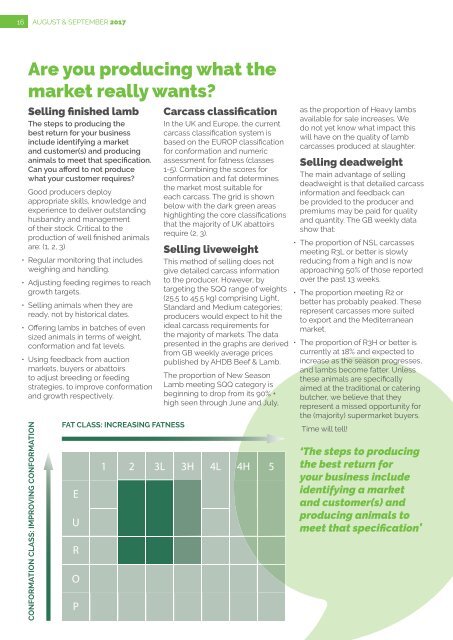Sheep Matters - August/ September 2017
Welcome to this first edition of “SHEEP MATTERS” a new subscription based publication for the UK sheep industry. The aim of this publication is to help progressive farmers and professionals to keep aware of, and up-to date with, new developments in markets, consumer trends, research and technology and to help them consider how to make changes to their businesses to innovate and grow. For further information and to register your interest go to www.sheepmatters.co.uk
Welcome to this first edition of “SHEEP MATTERS” a new subscription based publication for the UK sheep industry. The aim of this publication is to help progressive farmers and professionals to keep aware of, and up-to date with, new developments in markets, consumer trends, research and technology and to help them consider how to make changes to their businesses to innovate and grow. For further information and to register your interest go to www.sheepmatters.co.uk
Create successful ePaper yourself
Turn your PDF publications into a flip-book with our unique Google optimized e-Paper software.
16<br />
AUGUST & SEPTEMBER <strong>2017</strong><br />
Are you producing what the<br />
market really wants?<br />
Selling finished lamb<br />
The steps to producing the<br />
best return for your business<br />
include identifying a market<br />
and customer(s) and producing<br />
animals to meet that specification.<br />
Can you afford to not produce<br />
what your customer requires?<br />
Good producers deploy<br />
appropriate skills, knowledge and<br />
experience to deliver outstanding<br />
husbandry and management<br />
of their stock. Critical to the<br />
production of well finished animals<br />
are: (1, 2, 3)<br />
• Regular monitoring that includes<br />
weighing and handling.<br />
• Adjusting feeding regimes to reach<br />
growth targets.<br />
• Selling animals when they are<br />
ready, not by historical dates.<br />
• Offering lambs in batches of even<br />
sized animals in terms of weight,<br />
conformation and fat levels.<br />
• Using feedback from auction<br />
markets, buyers or abattoirs<br />
to adjust breeding or feeding<br />
strategies, to improve conformation<br />
and growth respectively.<br />
CONFORMATION CLASS: IMPROVING CONFORMATION<br />
FAT CLASS: INCREASING FATNESS<br />
E<br />
U<br />
R<br />
O<br />
P<br />
Carcass classification<br />
In the UK and Europe, the current<br />
carcass classification system is<br />
based on the EUROP classification<br />
for conformation and numeric<br />
assessment for fatness (classes<br />
1-5). Combining the scores for<br />
conformation and fat determines<br />
the market most suitable for<br />
each carcass. The grid is shown<br />
below with the dark green areas<br />
highlighting the core classifications<br />
that the majority of UK abattoirs<br />
require (2, 3).<br />
Selling liveweight<br />
This method of selling does not<br />
give detailed carcass information<br />
to the producer. However, by<br />
targeting the SQQ range of weights<br />
(25.5 to 45.5 kg) comprising Light,<br />
Standard and Medium categories;<br />
producers would expect to hit the<br />
ideal carcass requirements for<br />
the majority of markets. The data<br />
presented in the graphs are derived<br />
from GB weekly average prices<br />
published by AHDB Beef & Lamb.<br />
The proportion of New Season<br />
Lamb meeting SQQ category is<br />
beginning to drop from its 90% +<br />
high seen through June and July,<br />
1 2 3L 3H 4L 4H 5<br />
as the proportion of Heavy lambs<br />
available for sale increases. We<br />
do not yet know what impact this<br />
will have on the quality of lamb<br />
carcasses produced at slaughter.<br />
Selling deadweight<br />
The main advantage of selling<br />
deadweight is that detailed carcass<br />
information and feedback can<br />
be provided to the producer and<br />
premiums may be paid for quality<br />
and quantity. The GB weekly data<br />
show that:<br />
• The proportion of NSL carcasses<br />
meeting R3L or better is slowly<br />
reducing from a high and is now<br />
approaching 50% of those reported<br />
over the past 13 weeks.<br />
• The proportion meeting R2 or<br />
better has probably peaked. These<br />
represent carcasses more suited<br />
to export and the Mediterranean<br />
market.<br />
• The proportion of R3H or better is<br />
currently at 18% and expected to<br />
increase as the season progresses,<br />
and lambs become fatter. Unless<br />
these animals are specifically<br />
aimed at the traditional or catering<br />
butcher, we believe that they<br />
represent a missed opportunity for<br />
the (majority) supermarket buyers.<br />
Time will tell!<br />
‘The steps to producing<br />
the best return for<br />
your business include<br />
identifying a market<br />
and customer(s) and<br />
producing animals to<br />
meet that specification’



